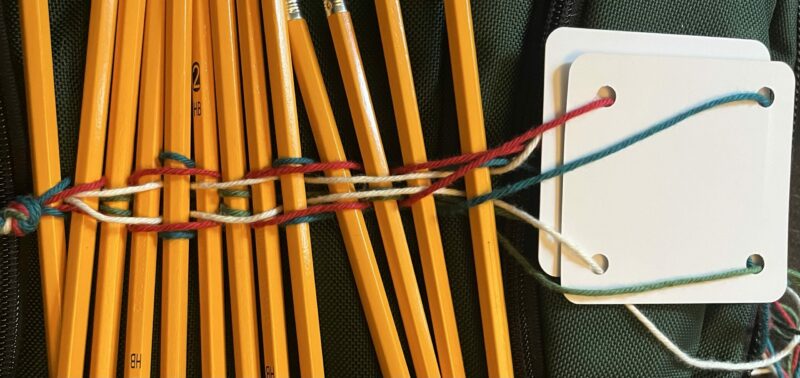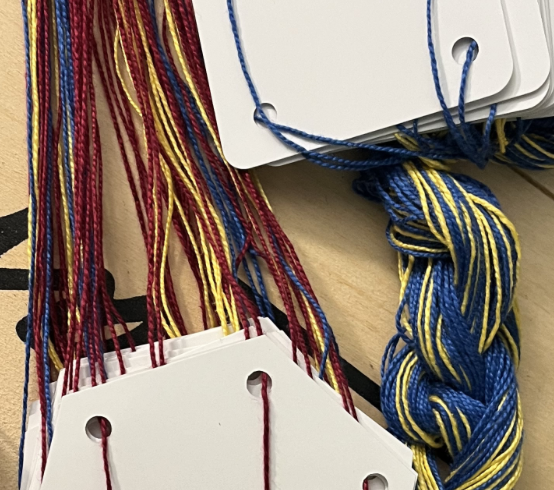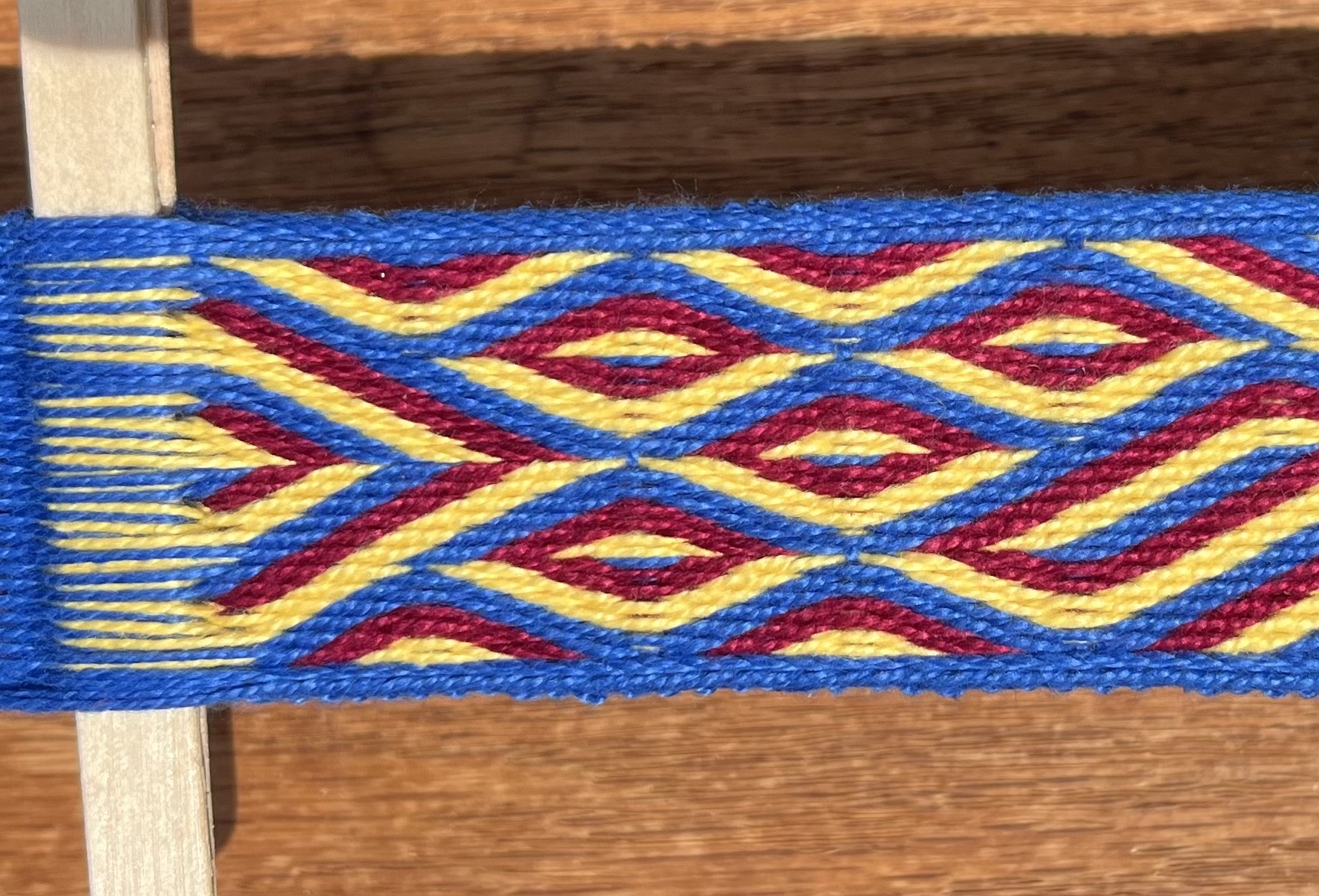First, the background. Sara Lamb is a self-described teacher of “esoteric weaving skills”, with a penchant for low-tech and simple equipment. Unsurprisingly, I admire her work, being rather fond of that sort of thing myself. Our specific paths are rather different – she has gone the color route, and I’m more about structure – but the underlying philosophy seems much the same. Sara is a professional weaver and well-respected teacher. Recently she had a post on her blog about teaching, and the different receptions that new teachers and established teachers can receive (note me carefully not using the word “old”), and the importance of a mix of both. Sara discussed teaching styles, and the teaching of techniques versus the teaching of projects. All in all, it was very thought-provoking. I left a comment, and there were many other interesting discussion points brought up. (Go read it. I’ll wait here until you get back.)
Sara found all the comments thought-provoking herself, and wrote a follow-up post. (Go read that one too.) She suggested that experienced teachers are what beginners want, because such teachers have a strong grasp of teaching the basics, and know where beginners struggle, and how to help them. Veterans, though, are interested in new teachers. Experienced fiber artists already have a solid grasp of the basics, and of the learning process, and are looking for something new, a spark or insight, even if that may not be wrapped in perfect poise and practiced style.
Sara went on to say, “I would take a class from Phiala, or Abby, or Michael, in a heartbeat. You can read the excitement they have in their work through their web presence, whether it is thoroughly answering questions in an online forum, or presenting their process on their personal websites. They have done their homework, and while their work is rooted in tradition, it is not bound by tradition. They know the back story of the work that they are doing, and they are exploring.”
I take it as a great compliment to have someone I respect say such things, and to group me with other fiber artists I respect, and who are more involved in the fiber arts community than I am. More challenged, than anything. Sara knows that I’m considering teaching classes, and this public affirmation suddenly takes it from “something I might try to figure out how to do someday” to “something I actually can and maybe should be thinking about now“. Different, and intimidating, and challenging.
Moving into the fiber world as an artist, participant, vendor, and especially teacher, presents two challenges for me. The first is that it requires me to move out of my comfort zone. I’m at home in the small world of medieval reenactment, especially within my own organization. I’m respected as an expert, and as a teacher. Outside that world, I’m a newcomer, and inexperienced, and that is intimidating. There’s overlap, with my website, and with the mailing lists I participate in, but my focus has been narrow, aimed at the medieval, and not looking to the wider world.
The second challenge for me is learning what I know. I know an awful lot of stuff – the history of things, how to do things, how things work. I take great delight in figuring things out, learning how they work, understanding them, and then using that understanding to make something. (As a reenactor, my greatest achievements are when I can make something that would look perfectly correct in a Viking household, and yet does not duplicate any particular extant item, because that means I understand the item and how it is made and the culture surrounding it. As a fiber artist, my goals are not so well defined.) I will admit to starting many more things than I finish, because once I understand the process actually doing it loses some of its allure. This is great for the SCA, where classes are short, and free, and expectations aren’t necessarily so high. But to teach a professional class, I need to take what I know, organize it, synthesize it, and craft it into something that I can legitimately ask people to pay for, and from which my students will take away both technique and inspiration.
This process of constructing and organizing a class is familiar, as I’ve taught before in more formal settings, but doing applying those skills to this setting is new. I’m sure that my hard-won (if a bit rusty) teaching skills will transfer, though certainly with some initial friction as I adapt them to a different audience with different expectations.
Starting this blog a year ago was my first move toward the wider world of string. Attending Complex Weavers and SOAR is the next step. I have many thoughts about what comes after, and I greatly appreciate the encouragement (and push!) as I move toward those farther-off ideas (which may not be as far-off as I’d been thinking). And I’m very, very much looking forward to meeting Sara, and Abby, and Michael at SOAR. Sparks? Yes, I expect so!






4 responses to “Creativity, inspiration and hard work”
I enjoyed reading this – very thinky! I’m looking forward to meeting you as well.
The main thing that I would say, is that the classes that I’ve been paid to teach, and the classes I’ve paid to take, in the “Real Fiber Arts World” have been very, very similar to the ones that I did for free in the SCA. People love doing the work they do, and they teach about it, and do their best to help other people fall in love with it too. I have always felt like it was important to provide good packets of materials and printed information – and it seems to me that the standard on that kind of thing in the RFAW is similar to the SCA’s. Only without the concern about periodicity.
When I first started getting paid real money (and sometimes quite good money, depending on the way it’s set up) to teach this stuff, I was terrified that I wasn’t going to be polished enough, or honestly just plain good enough, to be worth fifty bucks an hour – but having given and taken a reasonable number of classes, I realized that overall expectation wasn’t quite as high as I was scared it might be. I make nice photocopied handouts with photos illustrating some points, and lots of info – maybe a color cover, if I can.
It’s the same with demos. I used to demo with SCA folks, and it was always on a totally volunteer basis – maybe some of the demo venues would make a donation to the SCA, but mostly not. Because we loved what we did, we always went all-out and gave ’em a good show. Now, I’m doing the same thing, but with an hourly or a day rate.
Terrific post!
Your title says it all….
..and I’m so glad to read that you are serious about teaching “professional” classes… they will be worth every penny.
Great post & links–my teaching plans/ideas are on hold for now, but I still like to have more things to think about.
Very cool that you were cited! There is definitely an audience for whatever you end up teaching. I’d sign up in a heartbeat, too. ;)
The audience expectation is something I encountered as a student years ago–I was acquainted with the instructor of the bookbinding class I had just taken, and she commented that she didn’t think others in the class had been very excited to have made a bunch of models of cool book structures. (They were “real” books, just not with super fancy papers.) She, as a book artist, was excited to present us with Interesting Structures which we could use later in our own way, while I suspect that some of the others had expected to end up with something more polished. (I’ve seen this addressed lately where some class listings warn, “This is not a make and take!”) I took a number of classes with her afterwards: she addressed the issue by having us use fancier paper and other decorative techniques.
A final note–back in Las Cruces, I remember you admiring some delightful yarns, and rationalizing against their acquisition by saying they didn’t fit in with your historical focus. I doubted then that would be a permanent state! Sometimes a wildly colorful textured yarn is just the thing.
“Thinky” – I’m known for that, I’m afraid. (Actually, not afraid at all, I’m rather fond of that and use it frequently, though it does seem to put some people off a bit.)
I didn’t mean to imply that I teach bad classes to SCA people because they don’t pay me (and no, I don’t think you are accusing me of that, just clarifying a bit). Beginner classes especially get lots of prep work and handouts and all that stuff because my goal is to hook them firmly so they can’t escape! But I have little compunction about teaching half-baked or ill-defined classes to more advanced audiences. I don’t think I would do that for a paying audience, or at least not without a clear advance indication of what kind of class it will be.
Actually, now that I think of it, the half-baked and not-so-good class I’m really thinking of, on textile structures, would be a kickass three-day workshop. If I could find students nuts enough to want it, anyway.